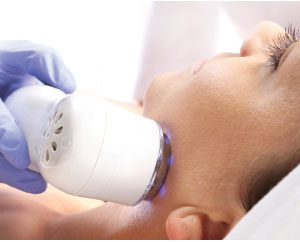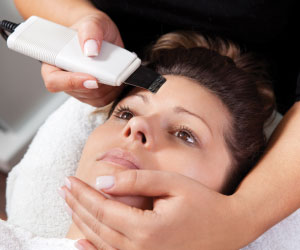What if you could create more effective acne treatments and increase service profits? Go beyond enzymes and peels to treat active acne. By incorporating modalities, such as LED, microcurrent, and ultrasonic spatula into treatment protocols, skin care professionals will not only maximize their clients’ results, but their profits as well.
 LED
LED
For the treatment of acne, blue and red LED are used to trigger intracellular photo-biochemical reactions. Specifically, through the excitation of coproporphyrin III and protoporphyrin IX at 410 to 420 nm (blue) and the stimulation of cellular repair at 633 nm (red).1,2
The activation of these porphyrins via blue light releases reactive, oxygen-free radicals that destroy the lipids in the cell wall of P. acnes bacteria. Because red light has a longer wavelength than blue light, it can destroy P. acnes bacteria residing deep in the sebaceous gland. In addition, red light is advantageous in the treatment of inflammatory acne lesions due to its ability to initiate the cellular repair cascade through cytokine activation. This, in turn, decreases inflammation and allows the skin to begin healing. The combination of blue and red LED may be more effective for severe acne.2
The efficacy of LED is strongly related to its power and wavelength. Treatment time, as well as distance from the skin’s surface, also plays a role in the overall effectiveness of the treatment, but to a lesser extent than power and wavelength. When choosing LED equipment, look for the following parameters: Joules (power): 4 to 9 j/cm2/second; Wavelength: blue (410 to 420 nm) and red (600 to 633 nm). Since LED has a more cumulative effect, rather than an immediate effect, a series of treatments (four to eight) is recommended.
Microcurrent
Microcurrent’s primary role in the treatment of acne is to mirror skin cell electrical current in order to normalize cell function. This enables skin cellular repair, decreases inflammation, and increases the healing of acne lesions. Microcurrent is most effective when the electrical current closely matches that of the cell (≤ 500µa).3 At this level of current, ATP (cellular energy) and protein synthesis increase dramatically to allow the skin cells to heal and return to their normal electrical state.
In addition, microcurrent assists in the treatment of acne by iontophoresis. Iontophoresis allows for penetration of water soluble products into the skin through electric current. The application of water-based serums with active ingredients, such as salicylic acid, may be more effective when followed by microcurrent.
Like LED, microcurrent exhibits a more cumulative effect. Therefore, a series of treatments (four to eight) is recommended to achieve optimal results.
 Ultrasonic Spatula
Ultrasonic Spatula
Utilizing an ultrasonic spatula during acne treatments amplifies exfoliation as well as product penetration. Exfoliation occurs due to the oscillation of the blade interacting with water on the skin. This provides a more controlled, even peeling. This rapid vibration also aids in the removal of open comedones.
Ultrasonic spatulas use sound waves to penetrate water-based products through the hydrophic barrier of the skin. This process is known as sonophoresis. In order to achieve the best results, the ideal frequency of an ultrasonic spatula is between 20 to 30 kHz.
There are many benefits to adding any of these modalities to treatment menus. Not only do these technologies provide a gentle experience for clients, but they also enhance results. They can easily be incorporated into any spa’s existing menu as either an add-on service or stand-alone treatment. For LED and microcurrent users, skin care professionals may consider adding a treatment series since results improve over the course of several treatments.
Treating acne can be challenging, but also very rewarding. Embracing these proven technologies in the treatment room will lead to a more profitable business and blissful clients.
References:
- Gold, M.H., et al., (2009). Clinical Efficacy of Self-applied Blue Light Therapy for Mild-to-Moderate Facial Acne, Journal of Clinical Aesthetic Dermatology. 2(3):44-50.
- Melville, N.A., (2007). Blue, Red LED Combo More Effective for Severe Acne, Dermatology Times.
- Cheng, N., (1982). The Effect of Electric Currents on ATP Generation, Protein Synthesis and Membrane Transport in Rat Skin, Clinical Orthopedics. 171:264-272.
Want to read more?
Subscribe to one of our monthly plans to continue reading this article.